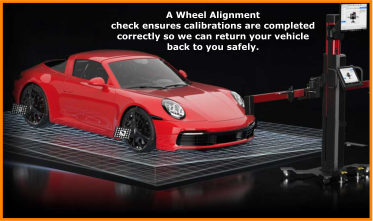

ADAS > (Advanced Driver Assistance Systems) Calibration Service - Page 1 of 3
On
an
ADAS
equipped
vehicle
(the
forward
facing
camera
or
cameras)
mounted
to
or
behind
your
vehicle’s
windshield
are
one
of
the
main
players
for
the
system
to
perform
properly.
When
we
perform
a
windshield
camera
calibration
on
your
vehicle
what
we
are
actually
doing
is
placing
the
forward
looking
windshield
camera
(or
camera’s)
center
point
on
what
is
referred
to,
in
the
engineering
world
as
The
Vanishing
Point
of
a
straight
and
level
well
marked
highway
at
a
very
specific
distance
in
front
of
your
vehicle.
In
order
for
your
vehicle’s
ADAS
Systems
to
perform
as
the
manufacturer
intended
it
to
it
is
absolutely
imperative
that
the
camera’s
center
point
be
placed
as
close
to
perfect
as
possible
to
the
green
target
point
in
the
center
of
the
camera’s
field
of
view
just
like
the
image
above
illustrates, where the lines on the highway intersect in the distance.
There are two types of windshield camera calibrations, Static and Dynamic
and there are some vehicles that actually require both types of calibrations be performed on them.
Static calibrations
All
vehicle
manufacturers
require
static
camera
calibrations
to
be
performed
in
a
controlled
indoor
environment
that
consists
of
bright
even
lighting
without
windows
or
back
ground
clutter
on
a
flat
level
floor.
A
calibration
stand
is
placed
in
front
of
the
vehicle
at
an
exact
distance
from
the
exact
center
line
of
the
vehicle
with
specific
targets.
The
targets
are
then
placed
at
an
exact
(to
the
millimeter)
position
on
the
calibration
stand.
After
that
the
camera
is
activated
by
a
calibration
tool
that adjusts it’s zero point position to the target or targets.
Dynamic Calibrations
To
perform
a
dynamic
calibration
it
takes
two
people
to
do
it
safely,
one
person
drives
the
vehicle
while
the
other
person
monitors
the
calibration
tool.
The
vehicle
is
driven
under
a
very
specific
set
of
driving
conditions.
It
must
be
done
in
the
day
light
hours
in
good
lighting
and
weather
conditions.
A
typical
speed
is
from
35
to
56
mph
on
well
marked
flat
straight
as
possible
roads.
Lane
changes
must
be
kept
to
a
minimum
as
well
as
maintaining
an
adequate
following
distance
behind
vehicles.
The
vehicle
must
be
driven
past
objects
the
camera
can
recognize
such
as
parked
cars,
guard
rails,
mail
boxes,
bill
board
and
road
signs.
The
more
objects
you
present
to
the
camera
the
more
accurate
the
calibration
will
be
and
the
calibration
time
will
also
complete
faster.
Under
the
right
conditions
a
dynamic
calibration
is
much
easier
and
faster
to
accomplish
in
most
cases.
There
are
some
exceptions
to
that
statement,
some
vehicles
like
a
Tesla
for
example
which
must
be
driven
under
the
above
conditions
in
excess
of
100
miles
before
the
dynamic
calibration
will
be
accomplished.
How long does it take to perform a windshield camera calibration on a vehicle?
•
Static calibrations in general take 1.5 to 3.5 hours to complete
•
Dynamic calibrations in general take 30 minutes to an hour to complete
•
A static and a dynamic calibration together in general takes 2 to 4 hours
•
The above times do not account for the actual windshield installation which usually takes 1.5 to 3 hours
99%
of
the
time
we
accomplish
your
windshield
installation
and
ADAS
calibrations
the
same
day
but
here
at
Phoenix
Glass
we
honestly
ask
you
for
a
2
day
service
window
to
repair
your
ADAS
equipped
vehicle.
The
time
it
takes
to
do
a
static
calibration
depends
on
your
specific
vehicle’s
setup
requirements.
The
actual
circumstances
involved
can
vary
greatly
for
each
make
of
vehicle
even
among
the
same
make
model
and
year.
If
your
vehicle
requires
both
a
static
and
a
dynamic
calibrations
there
will
be
more
time
needed
to
complete
it.
If
your
vehicle
requires
a
dynamic
calibration
weather
and
traffic
conditions
vary
greatly
throughout
any
given
day
and
we
would
be
lying
if
we
promised
you
we
can
accomplish
these
types
of
calibrations
by
appointment
on
any
given
day
in
a
small
window
of
time.
It’s
much
easier
to
part
with
your
vehicle
if
you
plan
on
it
being
out
of
service
for
2
days
rather
than
having
a
company
promise
it
will
be
ready
in
a
few
hours
and
then
telling
you
it
won’t
be
ready
until
the
weather
breaks
or
the
traffic
subsides
which
may
be
tomorrow
or
the
next
day.
An
even
worse
case
scenario
would
be
telling
you
that
you
would
have
to
bring
your
vehicle
back
on
another
day
which
puts
you
in
the position of having to drive an unsafe vehicle until you could return it for the calibration to be completed.
What if the camera or cameras are not properly calibrated?
If your vehicle is equipped with Lane Departure Warning (LDW)
depending on what other ADAS systems your vehicle may or may not have
if the vehicle’s windshield camera or camera’s are mis calibrated by so much as 1 degree:
•
Low - The vehicle will still alert you if you fail to maintain it within the center of the lane but the camera will not see a vehicle you’re
approaching in time to stop or alert you in time to prevent a collision.
•
High - The vehicle will still alert you if you fail to maintain it within the center of the lane but the camera won’t see a vehicle you’re
approaching at all and will not alert you to stop the vehicle to prevent a collision.
•
Left of Center - The vehicle will constantly alert you to steer your vehicle to the left into another lane or across the center line into
oncoming traffic.
•
Right of Center - The vehicle will constantly alert you to steer your vehicle to the right into another lane or off the road.
If your vehicle is equipped with Lane Keep Assist (LKA)
depending on what other ADAS systems your vehicle may or may not have
if the vehicle’s windshield camera or camera’s are mis calibrated by so much as 1 degree:
•
Low - The vehicle will still be able to maintain itself within the center of the lane but the camera will not be able see a vehicle you’re
approaching in time to stop the vehicle to prevent a collision.
•
High - The the vehicle will still be able to maintain itself within the center of the lane but the camera won’t see a vehicle you’re
approaching at all and will not make any attempt to stop the vehicle to prevent a collision.
•
Left of Center - The vehicle will constantly try to steer your vehicle left into oncoming traffic.
•
Right of Center - The vehicle will constantly try to steer your vehicle right into another lane or off the road.
OEM Vs OEE Windshields
Two
OEM
or
OEE
windshields
made
at
the
same
plant
at
the
same
time
on
the
same
manufacturing
line
can
and
do
in
most
instances
(in
our
real
world
experience’s)
have
camera
mounting
brackets
that
are
slightly
misaligned
but
still
within
tolerance.
The
windshield
placement
in
the
vehicle
can
also
be
slightly
misaligned
during
installation.
If
the
windshield
brackets
and
the
actual
windshield
installation
in
the
vehicle
are
within
tolerances
and
the
camera
or
cameras
are
calibrated
properly
everything
should
go
well.
You
can
and
we
have
searched
the
Internet’s
various
web
sites
and
found
data
and
studies
that
have
found
various
issues
with
OEE
windshields
but
once
again
we
would
have
to
say
that
in
our
real
world
hands
on
experiences
we
have
yet
to
personally
see
any.
That
being
said
we
need
to
say
that
here
at
Phoenix
Glass
we
are
a
small
company
and
do
not
turn
out
turn
out
anything
near
the
volume
of
windshield
installations
as
our
big
box
chain
store
competitors
do
year
in
and
year
out.
In
past
years
we
have
had
various
car
dealers
calibrate
our
windshield
cameras
as
well
as
companies
that
we
have
sub
contracted
our
calibration
work
too
and
we
have
never
had
a
calibration
failure.
In
our
experiences
from
2004
to
June
2023
we
have
not
seen
it
make
a
difference
if
we
installed
an
OEM
or
an
OEE
windshield
providing that:
•
The windshield is inspected for defects which we often find in both OEM and OEE parts.
•
The mounting brackets the camera or cameras mount to are properly attached and aligned on the windshield glass.
•
The windshield is properly installed in the correct position in the vehicle.
•
The vehicle is correctly pre conditioned prior to the windshield camera calibration procedure.

ADAS Windshield Camera Calibration
Many
newer
model
vehicles
are
equipped
with
advanced
driver
assistance
systems
(typically
referred
to
as
ADAS
systems)
that
use
one
or
more
cameras
as
well
as
light
detecting
and
ranging
sensors
known
as
LIDAR.
Added
to
that
are
a
host
of
other
sensors
such
as
rain,
humidity
and
light
sensors
mounted
on
the
windshield
that
can
affect
how
your
car
functions.
We
are
going
to
try
and
stay
focused
on
your
vehicle’s
windshield
camera
and
sensors
on
this
page
but
there
are
some
vehicles
that
also
require
a
radar
calibration when your windshield camera is calibrated.







When Calibration is Necessary
Camera
•
Windshield repaired or replaced.
•
Camera has been disconnected removed or replaced
•
Any air bag deployment
•
Wheel alignment (most vehicles)
•
Suspension work like struts, springs, shocks.
•
Changes in ride height
•
Changes in tire size
•
Diagnostic trouble codes are present
Radar
•
Radar sensor is removed or replaced
•
After a minor collision
•
Major collision repair
•
Bumper covers are removed or replaced
•
Grill removed and replaced
•
Wheel alignment
•
Diagnostic trouble codes are present

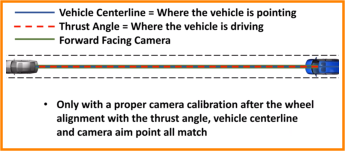
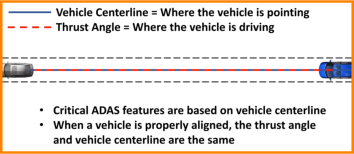
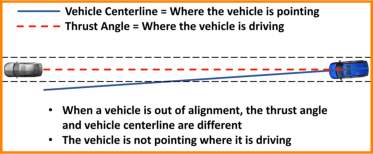
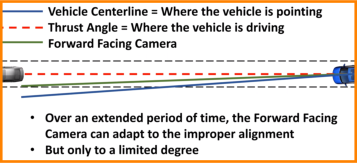

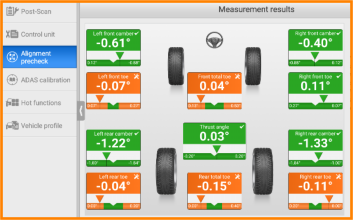
The wheel alignment on your vehicle also has a great deal to do with an ADAS windshield camera calibration
If
your
specific
vehicle
requires
it
t
he
examples
below
will
explain
and
show
you
why
it’s
important
we
check
the
wheel
alignment
on
your vehicle before we perform an ADAS windshield camera calibration on your vehicle.
An
ADAS
equipped
vehicle
needs
to
be
maintained
properly
for
all
the
systems
to
be
able
to
perform
as
the
manufacture
intended.
Dependent
on
your
vehicle’s
manufacture
as
well
as
the
year
make
and
model
it
maybe
a
requirement
that
you
have
a
your
vehicle’s
wheels
realigned
and
your
windshield
camera
re-calibrated
on
a
regular
basis.
Different
manufacturers
have
different
ideas
of
what
that
is.
It
ranges
from
every
other
oil
change
to
every
60,000
miles.
Again
(dependent
on
your
vehicles
year
make
and
model)
every
time
you
have
your
wheels
aligned
you
may
have
to
have
your
windshield
camera
re-calibrated.
If
your
vehicle’s
wheel
alignment
is
outside
of
the
manufacturers
specifications
and
we
calibrate
your
windshield
camera
the
system
will
not
be
able
perform
correctly.
That
does
for
a
fact
place
you
in
an
unsafe
situation
which
is
why
here
at
Phoenix
Glass
(if
your
specific
vehicle
requires
it)
we
check
your
wheel
alignment before we calibrate your windshield camera.

Copyright 2013 © Phoenix Glass, Inc. All Rights Reserved
Revised June 2023
Please Like Us
on Facebook











